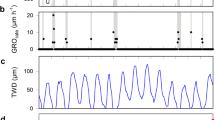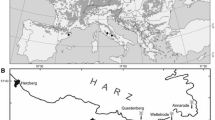Abstract
The significant mortality of the Austrocedrus chilensis (D. Don) Pic. Serm. et Bizarri forests, locally known as “Mal del Ciprés”, has been reported since 1945 for most sites across its distribution in Argentina. However, the cause of this decline is still a topic of discussion. In this study, radial growth patterns from symptomatic and asymptomatic A. chilensis trees were analyzed to determine the influence of drought events on tree growth. Fifty pairs of symptomatic and asymptomatic trees with similar DBH, competition, and microsite conditions were cored at five pure A. chilensis stands near El Bolsón, Río Negro, Argentina. A reference chronology from nonaffected trees was used to cross-date all cores and to determine the relationship between A. chilensis radial growth and climate. The growth of A. chilensis is favored by above average precipitation in late spring–early summer (November and December). A strong relationship was also observed between radial growth patterns and the Palmer drought severity index, a measure of the regional water deficit. Significant differences in growth patterns were recorded between symptomatic and asymptomatic trees. Following extreme drought events, the growth of symptomatic trees is consistently lower than in asymptomatic trees. Based on the larger number of droughts recorded during the past decades and on future climatic predictions suggesting increasing trends in the frequency and intensity of drought events in northern Patagonia, a gradual increase in the number of trees affected by “Mal del Ciprés” along the twenty-first century is likely expected.







Similar content being viewed by others
References
Amoroso MM (2009) Stand development patterns as a consequence of the decline in Austrocedrus chilensis forests. PhD Dissertation, University of British Columbia
Anderson TW (1957) An introduction to multivariate statistical analysis. Wiley, New York
Bigler C, Bugmann H (2003) Growth-dependent tree mortality models based on tree rings. Can J For Res 33:210–221
Bigler C, Bugmann H (2004) Predicting the time of tree death using dendrochronological data. Ecol Appl 14:902–914
Blasing TJ, Solomon AM, Duvick DN (1984) Response functions revisited. Tree Ring Bull 44:1–15
Breslow NE, Day NE (1980) Statistical methods in cancer research, vol.1: the analysis of case-control studies. International Agency For Research On Cancer, Lyon
Buamscha G, Gobbi M, Mazzarino MJ, Laos F (1998) Indicators of nitrogen conservation in Austrocedrus chilensis forests along a moisture gradient in Argentina. For Ecol Manage 112:253–261
Calí SG (1996) Austrocedrus chilensis: estudio de los anillos de crecimiento y su relación con la dinámica del “Mal del Ciprés” en el Parque Nacional Nahuel Huapi, Argentina. Trabajo para optar al grado de Licenciado en Ciencias Biológicas. Universidad Nacional del Comahue. Bariloche
Chauchard LM, Barnaba J (1986) Plan de Ordenación Forestal Cuartel Loma del Medio-Río Azul. Provincia de Río Negro. IFONA-Servicio Forestal Andino. Informe interno inédito
Cherubini P, Dobbertin M, Innes JL (1998) Potential sampling bias in long-term forest growth trends reconstructed from tree rings: a case study from the Italian Alps. For Ecol Manage 109:103–118
Christensen JH, Hewitson B, Busuioc A, Chen A, Gao X, Held I, Jones R, Kolli RK, Kwon W-T, Laprise R, Magaña Rueda V, Mearns L, Menéndez CG, Räisänen J, Rinke A, Sarr A, Whetton P (2007) Regional climate projections. In: Solomon S, Qin D, Manning M, Chen Z, Marquis M, Averyt KB, Tignor M, Miller HL (eds) Climate change 2007: the physical science basis. Contribution of working group I to the fourth assessment report of the Intergovernmental Panel on Climate Change. Cambridge University Press, Cambridge, New York, pp 847–940
Cook ER (1985) A time series analysis approach to tree-ring standardization. Ph.D. dissertation, University of Arizona, Tucson
Cordon V, Forquera JC, Gastiazoro J, Barros V, Schmidt I (1993) Estudio microclimático del área cordillerana del Sudoeste de la Pcia. de Río Negro. Cartas de precipitación. Facultad de Ciencias Agrarias, Cinco Saltos, Río Negro
Crow GR, Hicks RR (1990) Predicting mortality in mixed oak stands following spring insect defoliation. For Sci 36:831–841
Dai A, Trenberth KE, Qian T (2004) A global dataset of Palmer drought severity index for 1870–2002: relationship with soil moisture and effects of surface warming. J Hydromet 5:1117–1130
Dezzotti A, Sancholuz L (1991) Los bosques de Austrocedrus chilensis en Argentina: ubicación, estructura y crecimiento. Bosque 12:43–47
Dutilleul P, Till C (1988) Principal component analysis and discriminant analysis in dendrochronology. In: wood and archaeology. Hackens T, Munaut AV, Till C (eds). Acts of the European Symposium. Pact 22-I.3. Louvain-la-Neuve, Belgium, pp 37–52
El Mujtar VA, Andenmatten E (2007) “Mal del ciprés”: búsqueda de la causa más probable de daño mediante un análisis deductivo y comparativo. Bosque 28:3–9
Filip GM, Rosso PH (1999) Cypress mortality (mal del ciprés) in the Patagonian Andes: comparison with similar forest diseases and declines in North America. Eur J Forest Pathol 29:89–96
Fritts HC (1976) Tree rings and climate. Academic Press, New York
García-González I, Díaz-Vizcaíno EA, Martínez-Cortizas A (1997) Evidence for a common and species-specific climatic response of oak and birch on a northern Galician site (NW Spain) by means of multivariate procedures. Dendrochronologia 15:119–127
Goya JF, Ferrando JJ, Bocos D, Yapura P (1995) Estructura y desarrollo de un rodal coetáneo de Austrocedrus chilensis en El Bolsón, Río Negro, Argentina. Rev Fac Agron. La Plata 71:165–171
Greslebin AG, Hansen EM, Winton LM, Rajchenberg M (2005) Phytophthora species from declining Austrocedrus chilensis forests in Patagonia, Argentina. Mycologia 97:218–228
Havrylenko M, Rosso PH, Fontenla SB (1989) Austrocedrus chilensis: contribución al estudio de su mortalidad en Argentina. Bosque 10:29–36
Holmes R (1983) Computer-assisted quality control in tree-ring dating and measurement. Tree-Ring Bull 43:69–75
Kitzberger T, Veblen TT, Villalba R (1997) Climatic influences on fire regimes along a rain forest-to-xeric woodland gradient in northern Patagonia, Argentina. J Biogeog 24:35–47
Kozlowski TT (1982) Water supply and tree growth: part I water deficits. For Abs 43:57–95
Kozlowski TT, Kramer PJ, Pallardy SG (1991) The physiological ecology of woody plants. Academic Press, San Diego
La Manna L, Rajchenberg M (2004) The decline of Austrocedrus chilensis forests in Patagonia, Argentina: soil features as predisposing factors. For Ecol Manage 190:345–357
La Manna L, Bava J, Collantes M, Rajchenberg M (2006) Características estructurales de los bosques de Austrocedrus chilensis afectados por “mal del ciprés” en Patagonia, Argentina. Bosque 27:135–145
Labraga JC (1998) Escenario de Cambio Climático para la Argentina. Ciencia Hoy 8:18–25
Manion PD (1981) Tree disease concepts. Prentice Hall, New Jersey
McLachlan GJ (1992) Discriminant analysis and statistical pattern recognition. Wiley, New York
Monserud RA (1976) Simulation of forest tree mortality. For Sci 22:438–444
Mooney CZ, Duval RD (1993) Bootstrapping: a nonparametric approach to statistical inference. Sage university paper series on quantitative applications in the social sciences, series no. 07–095. Newbury Park, California
Palmer WC (1965) Meteorological Drought. U.S. Dep. Commerce. Weather Bureau Res. Paper 45
Pedersen B (1998) The role of stress in the mortality of midwestern oaks as indicated by growth prior to death. Ecology 79:79–93
Rajchenberg M, Cwielong PP (1993) El Mal del Ciprés (Austrocedrus chilensis): su relación con las pudriciones radiculares y el sitio. Congreso Forestal Argentino y Latinoamericano, Paraná, Entre Ríos
Schulman E (1956) Dendroclimatic change in semiarid America. University of Arizona Press, Tucson
Servicio Meteorológico Nacional (1981) Estadísticas climatológicas 1971–1980. Serie B. N°35. Servicio Meteorológico Nacional, Buenos Aires
Stokes MA, Smiley TL (1968) An introduction to tree-ring dating. University of Chicago Press, Chicago
Suarez M, Ghermandi L, Kitzberger T (2004) Factors predisposing episodic drought-induced tree mortality in Nothofagus-site, climatic sensitivity and growth trends. J Ecol 92:954–966
Swetnam TW (1993) Fire history and climate change in giant sequoia groves. Science 262:885–889
Tortorelli LA (1947) Los incendios de bosques en la Argentina. Ministerio de Agricultura de la Nación, Buenos Aires
Varsavsky E, Bettuci L, Rodríguez García D, Gómez C (1975) Observaciones preliminares sobre la mortalidad del ciprés (Austrocedrus chilensis) en los bosques patagónicos. Fundación Bariloche, publicación Nº 19
Veblen TT, Hadley KS, Reid MS, Rebertus AJ (1991) Methods of detecting past spruce beetle outbreaks in rocky mountain subalpine forests. Can J For Res 21:242–254
Veblen TT, Burns BR, Kitzberger T, Lara A, Villalba R (1995) The ecology of the conifers of southern America. In: Enright NJ, Hill RS (eds) Ecology of the southern conifers. Melbourne University Press, Melbourne, pp 120–155
Veblen TT, Kitzberger T, Villalba R, Donnegan J (1999) Fire history in northern Patagonia: the roles of humans and climatic variation. Ecol Monog 69:47–67
Villalba R, Veblen TT (1997a) Regional patterns of tree population age structures in northern Patagonia: climatic and disturbance influences. J Ecol 85:113–124
Villalba R, Veblen TT (1997b) Spatial and temporal variation in Austrocedrus growth along the forest-steppe ecotone in northern Patagonia. Can J For Res 27:580–597
Villalba R, Veblen TT (1998) Influences of large-scale climatic variability on episodic tree mortality in northern Patagonia. Ecology 79:2624–2640
Villalba R, Cook ER, Jacoby GC, D’Arrigo RD, Veblen TT, Jones PD (1998) Tree-ring based reconstruction of northern Patagonia precipitation since AD 1600. Holocene 8:659–674
Waring RH, Pitman GB (1985) Modifying lodgepole pine stands to change susceptibility to mountain pine beetle attack. Ecology 66:889–897
Wigley TML, Briffa KR, Jones PD (1984) On the value of correlated time series, with applications in dendroclimatology and hydrometeorology. J Clim Appl Meteorol 23:201–213
Willis B (1914) El norte de la Patagonia, naturaleza y riquezas. Tomo I. Ministerio de Obras Públicas, Buenos Aires
Woodward M (1999) Epidemiology: study design and data analysis. Chapman and Hall/CRC, Boca Ratón, Florida
Acknowledgments
This research was supported by the Agencia Nacional de Promoción Científica y Tecnológica of Argentina (PICT 25518) and by a CONICET doctoral fellowship (National Council for Scientific and Technical Research of Argentina). We are grateful to Marcelo Arturi, Mariano S. Morales, María Laura Suarez, Alberto Ripalta and Andrés Manceñido for research assistance. We also thank two anonymous reviewers for helping to improve the final version of this manuscript.
Author information
Authors and Affiliations
Corresponding author
Additional information
Communicated by A. Gessler.
Rights and permissions
About this article
Cite this article
Mundo, I.A., El Mujtar, V.A., Perdomo, M.H. et al. Austrocedrus chilensis growth decline in relation to drought events in northern Patagonia, Argentina. Trees 24, 561–570 (2010). https://doi.org/10.1007/s00468-010-0427-8
Received:
Revised:
Accepted:
Published:
Issue Date:
DOI: https://doi.org/10.1007/s00468-010-0427-8




